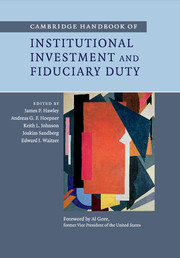Book contents
- Frontmatter
- Contents
- List of figures
- List of tables
- List of contributors
- Foreword
- 1 Introduction
- Part I Fiduciary duty: a global outlook
- Part II Fiduciary duty and the landscape of institutional investment
- Part III Challenging conventional wisdom on fiduciary duty
- Part IV Towards a broader interpretation of fiduciary duty
- Part V Beneficiaries’ roles and viewpoints
- Part VI Fiduciary duty and governance
- 30 Investors and global governance frameworks: broadening the multi-stakeholder paradigm
- 31 Promoting corporate sustainability through integrated reporting: the role of investment fiduciaries and the responsibilities of the corporate board
- 32 Reporting and standards: tools for stewardship
- 33 US corporate governance, fiduciary success and stable economic growth
- 34 Fulfilling fiduciary duties in an imperfect world – governance recommendations from the Stanford Institutional Investor Forum
- 35 Addressing the participation gap in institutional investment: an assessment framework and preliminary results
- 36 The costs of fiduciary failure – and an agenda for remedy
- Index
- References
35 - Addressing the participation gap in institutional investment: an assessment framework and preliminary results
Published online by Cambridge University Press: 05 April 2014
- Frontmatter
- Contents
- List of figures
- List of tables
- List of contributors
- Foreword
- 1 Introduction
- Part I Fiduciary duty: a global outlook
- Part II Fiduciary duty and the landscape of institutional investment
- Part III Challenging conventional wisdom on fiduciary duty
- Part IV Towards a broader interpretation of fiduciary duty
- Part V Beneficiaries’ roles and viewpoints
- Part VI Fiduciary duty and governance
- 30 Investors and global governance frameworks: broadening the multi-stakeholder paradigm
- 31 Promoting corporate sustainability through integrated reporting: the role of investment fiduciaries and the responsibilities of the corporate board
- 32 Reporting and standards: tools for stewardship
- 33 US corporate governance, fiduciary success and stable economic growth
- 34 Fulfilling fiduciary duties in an imperfect world – governance recommendations from the Stanford Institutional Investor Forum
- 35 Addressing the participation gap in institutional investment: an assessment framework and preliminary results
- 36 The costs of fiduciary failure – and an agenda for remedy
- Index
- References
Summary
Introduction
This chapter shows how fiduciary duty and the governance quality of investment can be understood using a stakeholder-based approach. In the past, stakeholders were effectively passive economic actors, who were supposed to just sit back and reap rewards. This view is increasingly being challenged by the assertion that large investors should care about governance as well as economic outcomes, and have both a right and a responsibility to ensure that assets are managed in a way that is socially and environmentally beneficial for all stakeholders. Contemporary governance theory argues for a wider understanding of stakeholders, which, in the case of investment, encompasses both financial and nonfinancial interests. This chapter examines the changing nature of “stakeholderism,” and explores its tensions and contradictions, using responsible investment as a case study. A survey of stakeholders involved in responsible investment follows. The results reveal interesting views about the governance quality of some central aspects of the sector’s architecture, and thus provide useful learning points for institutional investment and fiduciary duty in general.
Changing conceptions of stakeholder rights and responsibilities
It has been argued that developments in institutional governance in the wake of the 1992 Rio “Earth” Summit, with its emphasis on sustainable development, necessitate a fundamental rethink of what constitutes a “stakeholder” in investment that claims to be truly “responsible.” The definition has become far more all-encompassing, and now includes non-governmental organizations (NGOs, sometime also referred to as civil society or civil society organizations – CSOs), the general public and local communities, unions, private business, ethical shareholder groups and small shareholders, as well as traditional interests such as governments, regulatory authorities and large-scale investors (Cadman 2011a). If it is accepted that the investment community is made up of a wide range of participants, from traditional “internal” interests (e.g., banks, financial advisors and asset managers) to “external” groups in civil society, and that these interests all have a “stake” in investment activities, it is necessary to look beyond “corporate” governance as a means of determining the legitimacy of current financial practice (Cadman 2011b).
- Type
- Chapter
- Information
- Publisher: Cambridge University PressPrint publication year: 2014



